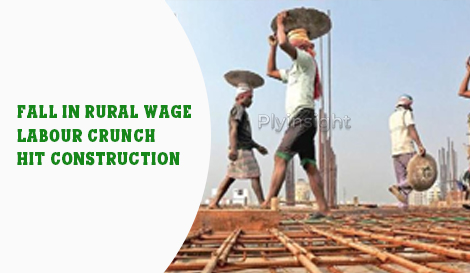
Fall in rural wage, labour crunch hit construction
- अप्रैल 8, 2022
- 0
Industry veterans feel a dip in rural wages, unemployment, unprecedented rains and labour shortage in urban areas are the key reasons for the contraction of 2,8 per cent in the construction sector during Q3. The construction sector’s figures were part of the GDP numbers released recently by the National Statistical Office (NSO).
Corporate players are expecting construction activity to pick up during the current quarter.
However, many of them say that sectors like cement are not seeing demand rise compared to a normal fourth quarter, while input costs are on the rise.
“There was a dip in rural wages and a reduction of disposable money in the hands of people. Unemployment has also gone up and resulted in contraction and drop in rural demand. This was in addition to the Covid impact on the construction sector,”
Based on government data, A decline was seen in non-farm wages that fell to 1.8 per cent from 7.9 per cent during April-November 2020.
“The observed contraction is large because construction activity during the festive quarter (October- December) slows down due to construction labourers returning to their hometowns to celebrate festivals,”
“Since it is a labour-intensive sector, the biggest raw material for the construction secotr is manpower. The working class in north India come back to work after Chath Puja. Hence, there was a serious impact on demand during the months of December and January. Rural consumption was sustainable for us, but the urban market was unpredictable,” it was observed.
“As far as the construction sector’s contraction in Q3 is concerned, it does come as a surprise. But the low-base effect waning is also a reason for that. If we look at it sequentially, it continues to grow,”
“Over a longer period of time, construction GDP is expected to pick up as mobility restrictions are eased and investment activity picks up,”
ग्रामीण मजदूरी घटने से निर्माण पर असर
उद्योग जगत के दिग्गजों का मानना है कि ग्रामीण मजदूरी में कमी, बेरोजगारी, अप्रत्याशित बारिश और शहरी इलाकों में श्रमिकों की कमी की वजह से तीसरी तिमाही के दौरान निर्माण क्षेत्र में 2.8 प्रतिशत संकुचन आया है।
राष्ट्रीय सांख्यिकी कार्यालय (एनएसओ) द्वारा हाल में जारी जीडीपी के आंकड़ों में निर्माण क्षेत्र के आंकड़े भी शामिल थे। कॉर्पाेरेट दिग्गजों को उम्मीद है कि चालू तिमाही के दौरान निर्माण गतिविधियों में गति आएगी।
बहरहाल इनमें से तमाम का कहना है कि सीमेंट जैसे क्षेत्र सामान्य चौथी तिमाही की तुलना में मांग में कोई बढ़ोतरी नहीं देख रहे हैं, वहीं इनपुट की लागत बढ़ रही है।
‘ग्रामीण मजदूरी में कमी आई है और लोगों के हाथ में खर्च करने योग्य धन कम हुआ है। बेरोजगारी भी बढ़ी है, जिसकी वजह से संकुचन और ग्रामीण मांग में कमी आई है। निर्माण क्षेत्र पर कोविड के असर के अतिरिक्त इनका असर है’।
सरकार के आंकड़ों के मुताबिक इस वित्त वर्ष में अप्रैल नवंबर के दौरान औसत नॉमिनल कृषि मजदूरी वृद्धि कम हुई है। गैर कृषि मजदूरी भी अप्रैल-नवंबर 2020 के 7.9 प्रतिशत की तुलना में गिरकर 1.8 प्रतिशत रह गई हैं।
‘निर्माण गतिविधियों में त्योहारी मौसम (अक्टूबर दिसंबर) में कमी की एक बड़ी वजह यह है कि निर्माण श्रमिक त्योहार मनाने अपने गृह जनपद लौट जाते हैं’।
यह श्रम आधारित क्षेत्र है और निर्माण क्षेत्र का सबसे बड़ा कच्चा माल मानव शक्ति है। उत्तर भारत का कामगार छठ पूजा के बाद काम पर वापस लौटा। ऐसे में दिसंबर और जनवरी के दौरान मांग पर गंभीर असर पड़ा।
ऐसा मानना है कि ग्रामीण खपत टिकाऊ थी, लेकिन शहरी बाजार का अनुमान लगाना मुश्किल था।
जहां तक तीसरी तिमाही में निर्माण क्षेत्र में संकुचन का सवाल है, यह आश्चर्यजनक रहा। लेकिन कम आधार का असर खत्म होना भी एक वजह है। अगर हम क्रमिक आधार पर देखें तो वृद्धि जारी है।
‘‘लंबी अवधि में, निर्माण जीडीपी में तेजी आने की उम्मीद है क्योंकि गतिशीलता प्रतिबंधों में ढील दी जा रही हैं और निवेश गतिविधि तेज हो रही है,’’
































































